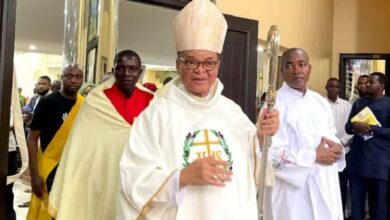Nkonya-Alavanyo must smoke peace pipe Says Bishop Mante
By Damian Avevor
The Bishop of Jasikan, Most Rev. Gabriel Mante, has expressed deep worry at the continuous communal land dispute between the Nkonyas and the Alavanyos in the Volta Region, calling on them as a matter of utmost importance and urgency to smoke the peace pipe.
He said the Nkonyas and the Alavanyos were one people not only created in the image and likeness of God, but because of their proximity to one another had also intermarried for generations and established a variety of social relationships.
He, therefore, could not understand why this long-standing dispute could not be resolved once and for all.
Bishop Mante expressed these views in an interview with The Catholic Standard at Nkonya-Ahenkro during the climax of the Centenary celebrations of Catholicism in the town on February 8, 2016.
In response to a question about the main factor inhibiting the settlement of the dispute, he stated that unless the settlement of the dispute is underpinned by truth and justice genuine peace unity and between the two communities would not be attained.
This alone, he said, could completely resolve the matter, advising that stakeholders who were helping to end the conflict must not to take sides in the dispute.
He reiterated and stressed several times that for peace to prevail between the two communities, the fundamental principles of truth and justice must not be underestimated or overlooked.
In this regard, he commended the National Peace Council, which had been entrusted to mediate the matter for its untiring efforts, but called on it to quickly come out with enduring measures to end the conflict.
The Alavanyo and Nkonya conflict over a disputed boundary land started in 1923, and in 2005, a Mediation Committee was set up to assist the two communities to dialogue and resolve the problem.
The Bishop, who hails from Nkonya-Ahenkro, noted that human life was of concern to him and not even a further drop of blood on either side should be spilled.
He, therefore, passionately appealed to the few disgruntled groups in the two communities which were intermittently fuelling the dispute to cease their nefarious activities.
He said the two communities had come a long way after over 90 years of dispute, and it was time both communities got ready to put the past hostilities behind them for peace to prevail between them.
He recalled that the Alavanyo and Nkonya Mediation Committee put together in 2005, was at the threshold of achieving lasting peace, saying that the Committee’s efforts were so effective that its work attracted even the attention of the United Nations and some international peace building organisations
He regretted that these efforts stalled in 2011, giving rise soon after to renewed violence since then.
The Committee members included Most Rev. Francis Kofi Anani Lodonu, Bishop Emeritus of Ho, whose mother hailed from Alavanyo with Very Rev. Dr. Livingstone Buama, the then Moderator of the Evangelical Presbyterian Church, Ghana as the Chairman of the Committee.
The other members were Nana Mprah Besemuna III, the Krachiwura, Mama Adokuwa Asigbe IV, the late Queen Mother of Tefle Traditional Area, Mrs. Felicia Otchere-Darko, the then Chief State Attorney of the Volta Region and Mrs. Hilary Gbedemah, the former President of International Federation of Female Lawyers. Mr. Emmanuel Bombande, the former Executive Director, West Africa Network for Peace Building, was the principal facilitator for the peace process in the two communities.
Bishop Mante said the Committee, of which he was a member, as a means of executing its mandate established local structures like a Consultative Committee and Community Peace Setters.
These structures, he said, using traditional, social and Christian approaches, enabled the two traditional areas to engage each other to iron out their differences and suspicions.
This, he said, resulted in the restoration of social interactions among the people of the two traditional areas which culminated in the traditional rites of concluding peace on the boundary between Nkonyas and Alavanyos on Nkonya-Hohoe road in May 2009.
The Bishop of Jasikan explained that during dialogue with the two parties, it was realised that some people did not even know the demarcation of the disputed land boundaries for which they fought. The two parties therefore agreed that the land should be surveyed and demarcated.
According to the Bishop, the Government engaged two different State Surveyors to survey the land and produce maps according to the claims of the two parties. “When the surveyors completed their work the maps were officially and publicly presented to the Chiefs, Elders and leading members of the two communities”, he added.
He noted that the questions which remained to be answered after the exhibition of the maps were either which part of the land truly belonged to each party or what was to done with the land.
Answers emerged, but they seemed unsatisfactory to either of the parties, he added.
